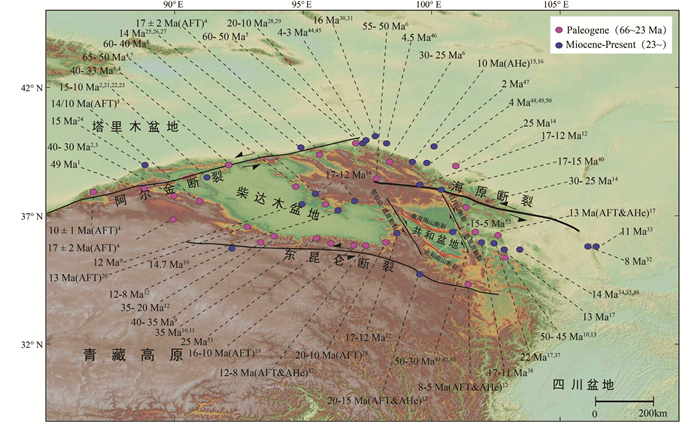2. 中国地质大学(北京), 北京 100083;
3. 南方海洋科学与工程广东实验室, 广州 511458;
4. 青海省水文地质工程地质环境地质调查院, 西宁 810008;
5. 中国石油新疆油田分公司勘探开发研究院, 克拉玛依 834000
2. China University of Geosciences (Beijing), Beijing 100083;
3. Southern Marine Science and Engineering Guangdong Laboratory, Guangzhou 511458, China;
4. Qinghai Survey Institute of the Hydrogeology and Engineering & Environmental Geology, Xining 810008, China;
5. Petroleum Exploration and Development Institute, Xinjiang Oilfield Company, Petrochina, Karamay 834000, China
青藏高原作为世界上规模最大、最年轻的高原,对区域和全球的气候变化、地貌演变等产生了重要的影响,高原的成因动力学、差异的隆升时间和范围是近来研究的热点(An et al., 2001; Tapponnier et al., 2001; Molnar, 2005; Craddock, 2011; Craddock et al., 2014; Clark, 2012; Yuan et al., 2013; Wang et al., 2014; Ding et al., 2017; He et al., 2017, 2018; Cheng et al., 2019, 2021; Lin et al., 2021; Liu et al., 2021; Wu et al., 2021)。东昆仑山、祁连山脉作为高原扩展的前缘是理解青藏高原东北部的构造演化、隆升过程的关键区域,它们记录了新元古代-早古生代以来复杂的构造、岩浆及变质事件(Bovet et al., 2009; Zheng et al., 2010; Duvall et al., 2013; Wang et al., 2016a, 2018; Zhuang et al., 2018; Pang et al., 2019; Yu et al., 2019; Li et al., 2020, 2021; Wu et al., 2021),但其隆升事件启动时间及隆升过程仍存在争议。
青藏高原东北部隆升的初始时间、范围有不同的认识。近来,低温热年代学方法通过限定岩石或矿物在某时间点上所处的温度,反演岩石或矿物所经历的温度演化过程,从而用于揭示构造剥露、埋藏及古地貌(Braun, 2002; Gleadow et al., 2002; Reiners and Shuster, 2009; Fox and Shuster, 2014; Yu et al., 2014; 李广伟, 2021)。青藏高原东北部广泛存在区域性的侏罗纪-早白垩世的隆升事件(Mock et al., 1999; Jolivet et al., 2001; Liu et al., 2005, 2017, 2021; Duvall et al., 2013; Wang et al., 2018; Zhuang et al., 2018; Li et al., 2019; Zattin and Wang, 2019),被认为与拉萨地体和羌塘地体的碰撞相关;也有认为隆升初始在晚新生代(Tapponnier et al., 2001)及早白垩世-早新生代(Lin et al., 2021)。也有研究认为隆升初始在中生代,但新生代存在多期次隆升事件,如认为东昆仑造山带初始隆升在侏罗纪,后经历了白垩纪、新生代始新世早期、中新世中期和上新世等4期主要的冷却-隆升事件(陈宣华等, 2011);亦有认为热演化具有分带性,如祁连山其南部在古新世至始新世经历了显著的地壳缩短,而中部和北部在渐新世发生折返(Jolivet et al., 2001; Bovet et al., 2009; Craddock, 2011; Craddock et al., 2014; He et al., 2017, 2018; Zhuang et al., 2018; Cheng et al., 2019, 2021)。
青海共和盆地位于青藏高原东北部,秦岭-祁连-昆仑造山带结合处,是原特提斯与古特提斯体系叠置区域(张宏飞等, 2006; 张雪亭, 2006; 郭安林等, 2007; 孙知新等, 2011; 李瑞保等, 2016; 杨瀚文等, 2018),也是研究盆-山耦合、构造演化的理想位置。近几年在共和盆地东北部发现异常高温的干热岩体(薛建球等, 2013; 严维德, 2015; 张森琦等, 2018; Feng et al., 2018),其热源机制与热历史过程是研究难点。共和盆地与周缘造山带之间构造热演化的研究可为青藏高原东北部差异隆升时限及范围提供新证据,也可为干热岩经历的热历史过程及热藏潜力提供重要线索。
本文主要采集共和盆地北缘青海南山北侧元古代、青海南山南侧沟后杂岩体、共和盆地瓦里贡-过马营隆起北部当家寺岩体南、北露头样品,进行了磷灰石和锆石(U-Th)/He及磷灰石裂变径迹分析,建立了年龄-海拔剖面,结合周缘中-新生代热事件,研究盆地东北缘盆山结合部三叠纪以来的热历史过程,为盆地东北缘的差异性隆升提供了新的证据,并对共和盆地干热岩地热资源的研究有所启示。
1 地质背景共和盆地位于秦岭、祁连、昆仑造山带结合部(石宝颐和张峻太, 1982; 姜春发等, 2000; 张国伟等, 2004),是一个中-新生代山间盆地,盆地总体走向呈NWW-SEE向,平面上表现为东宽西窄的菱形,长约210km,最宽处约90km,海拔2600~3200m(王昌桂和吕友生, 2004; 施炜等, 2006)。盆地北以宗务隆山-青海南山断裂为界,西为鄂拉山-温泉断裂带,南为阿尼玛卿缝合带,东为多禾茂断裂带,盆地中东部的瓦里贡-过马营隆起将盆地主体分割成西、东斜列的共和坳陷和贵德坳陷(图 1)。
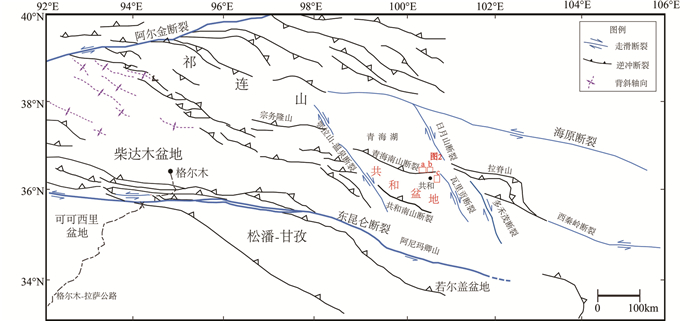
|
图 1 共和盆地大地构造位置图(据Yin et al., 2008; Wu et al., 2019a修改) Fig. 1 Tectonic sketch map of the northeastern Tibetan Plateau (modified after Yin et al., 2008; Wu et al., 2019a), showing the Gonghe basin, major faults and the position of Fig. 2 |
共和盆地东北缘主要发育古元古代化隆群(Pt1H1),主要由片麻岩、斜长角闪岩、混合岩和大理岩组成;泥盆纪赛日钦灰白色中细粒花岗闪长岩(Dγδ);晚石炭-中二叠世中吾农山群果可山组(CPgk),主要为灰白色厚层状结晶灰岩夹砂岩、板岩(图 2)(拜永山等, 2007①; 郭现轻等, 2016);早-中三叠世隆务河组浊流相砂板岩(T1-2l),主要为灰黑色泥质板岩夹浅灰色砂质板岩薄互层,偶见灰色砂岩夹砾岩层段,可见完整的鲍马序列。三叠纪还发育不同时期的中酸性、中基性侵入体,多侵入到早-中三叠世隆务河组中,花岗岩是目前共和盆地干热岩地热藏的主要载体(薛建球等, 2013; 严维德, 2015; 张森琦等, 2018; Feng et al., 2018; 陈希节等, 2020; 贠晓瑞等, 2020)。沟后杂岩体位于青海南山构造带东段,共和县城北侧,主要由辉长岩、辉长闪长岩、石英闪长岩、花岗闪长岩组成,形成于约249~238Ma,具壳幔岩浆混合特征(张永明等, 2017b; 贠晓瑞等, 2020)。当家寺岩体位于龙羊峡水库北侧,共和盆地瓦里贡-过马营隆起的北部,主要由正长花岗岩、二长花岗岩和花岗闪长岩组成,结晶年龄分别为243.5±2.9Ma(石玉莲等, 2018)、240.1±2.1Ma、240.0±2.6Ma(张永明等, 2017a),其形成于下地壳基性岩为主的部分熔融,有一定程度的幔源岩浆贡献。盆地北部干热岩钻井GR1井钻遇的奥长花岗岩、英云闪长岩,结晶年龄分别为236.5±1.7Ma、241.6±3.0Ma,为准铝质,属于高钾钙碱性系列(陈希节等, 2020)。总体上,该区基性侵入岩的形成时代早于中性侵入岩,中性侵入岩早于中酸性侵入岩;在早-中三叠世,处于宗务隆-青海南山-西秦岭北缘统一的大陆边缘弧环境下,花岗岩组合的形成与印支期宗务隆洋的南向俯冲作用密切相关(张永明等, 2019; 陈希节等, 2020);而在241~236Ma时发生俯冲-碰撞转换,晚三叠世时宗务隆-青海南山-西秦岭北缘已处于碰撞期和后碰撞期(陈希节等, 2020)。研究区内出露的新生代地层以新近纪临夏组(N2l)和第四系(Q)为主,主要发育河流-湖泊相、冲-洪积相的砂岩、粉砂岩及砾岩沉积。
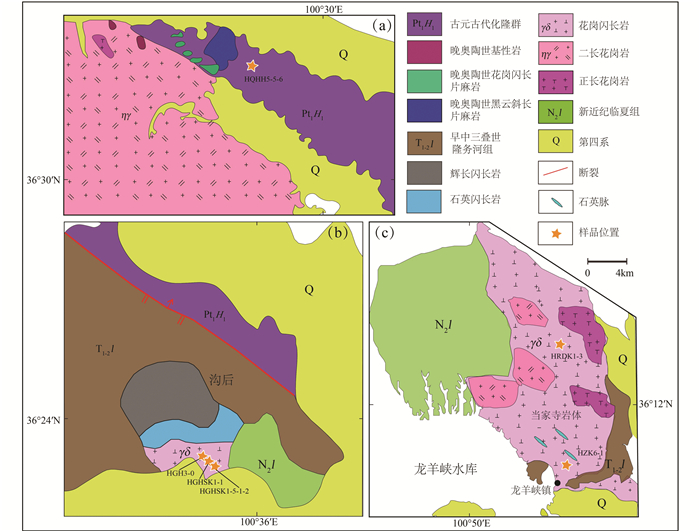
|
图 2 青海南山东部(a)、沟后杂岩体(b)和当家寺岩体(c)地质简图(据拜永山等, 2007; 张永明等, 2017b修改)及样品位置 Fig. 2 Simplified geologic map of the eastern part of Qinghai-Nan Shan (a), the Gouhou intrusive complex (b) and the Dangjiasi pluton (c) (modified after Zhang et al., 2017b), sample locations are shown |
① 拜永山, 王秉璋, 王永文, 王进寿, 丁西岐, 王培俭, 曹生秀. 2007. 1︰25万西宁幅区域地质调查报告. 西宁: 青海省国土资源厅资料馆, 1-1282
研究区发育青海南山断裂和瓦里贡断裂两个主要断裂带。青海南山断裂为共和盆地北缘边界断裂,是宗务隆-青海南山-西秦岭断裂的中段,为一北西走向、北东倾向、倾角40°~60°不等的逆冲断裂带,并伴有左行走滑,在盆地北缘延伸超过200km;该断裂长期活动,初始活动起始于二叠纪或更早,三叠纪活动强烈(张启胜和张敏, 1996; 张盛生等, 2019),上新世中期以来至今仍在活动(Craddock et al., 2014; 王洪等, 2021)。瓦里贡断裂带为共和盆地主要坳陷的分界断裂带,由多条分段断裂组成,呈北北西走向,为右行走滑逆冲断裂,断裂起始活动于三叠纪(李锦轶和张进, 2015),新生代仍然活动。
2 样品特征本文样品均采集自青海南山东段、沟后杂岩体及共和盆地东北缘当家寺岩体野外露头。其中样品HQHH5-5-6采集自青海南山北侧,为古元古代黑云母片麻岩(图 2a、图 3a, b),黑云母半定向排列,片麻状结构。在沟后杂岩体采集了3个样品,HGH3-0为灰黑色黑云闪长岩(图 2b、图 3c);HGHSK1-1为蚀变花岗岩含石英脉(图 2b、图 3d, e);HGHSK1-5-1-2为黑云斜长花岗岩,粒度较粗,斜长石发生绢云母化(图 3f);LA-ICP-MS锆石U-Pb定年获得HGH3-0结晶年龄为238.5±2.1Ma(MSWD=1.7)(贠晓瑞等, 2020)。在龙羊峡北侧当家寺岩体获得的样品HRDK1-3为粗粒黑云花岗岩(图 2c、图 3g, h),斜长石发育聚片双晶和蚀变环带;HZK6-1为灰白色黑云花岗岩(图 2c、图 3i),暗色矿物多为黑云母,斜长石高岭土化。这些样品构成了海拔高程2633.5~3700m的垂向剖面。
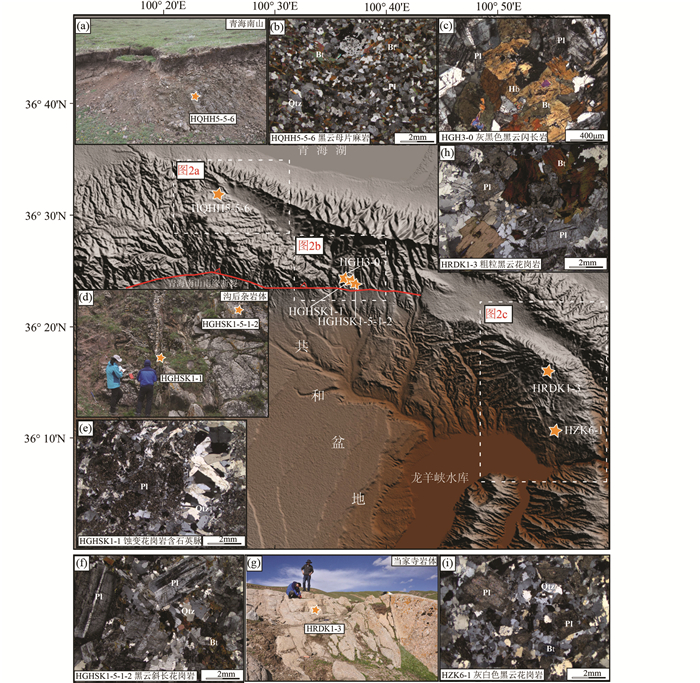
|
图 3 共和盆地东北缘野外露头照片和样品显微照片 底图为研究区数字高程图(数据来自地理空间数据云SRTMDEM 90M);Bt-黑云母;Hb-角闪石;Pl-斜长石;Qtz-石英 Fig. 3 Field outcrop photos and representative photomicrographs of the study samples in the northeastern margin of the Gonghe basin The base map is the digital elevation map of the study area (data from Geospatial Data Cloud SRTMDEM 90M). Bt-biotite; Hb-hornblende; Pl-plagioclase; Qtz-quartz |
(U-Th)/He测温系统对低温很敏感(Wolf et al., 1996),可对盆地和造山带的热历史提供约束。经过破碎和矿物分选,从新鲜的岩石样品中分选出足够的磷灰石和锆石颗粒,然后精选磷灰石和锆石颗粒进行(U-Th)/He测定。本文对共和盆地东北缘6个样品进行了磷灰石(U-Th)/He测试(AHe),对沟后杂岩体的1个花岗岩样品(HGH3-0)进行了锆石(U-Th)/He测试(ZHe)。
HGH3-0样品的磷灰石和锆石(U-Th)/He测试在墨尔本大学地球科学学院低温年代学实验室进行。首先在显微镜下选出晶形完好的、无裂痕、无包裹体的矿物颗粒(磷灰石、锆石),测量其大小。将挑选好的矿物颗粒放入铂金胶囊管内,真空条件下,磷灰石颗粒利用波长820nm的光纤耦合二极管激光进行加热除气,持续5分钟,加热温度为900℃,然后加入3He标准气体,具体气体含量通过Balzers四级杆质谱仪进行测算。锆石颗粒的除气过程加热温度为1300℃(激光功率为12.6W),持续20分钟,以保证4He的完全提取。除气后的锆石和磷灰石颗粒分别用HF-HNO3和HNO3溶液进行完全溶解,并通过Varian四级杆ICP-MS测试其U-Th(Sm)含量(Gleadow et al., 2015)。经放射性同位素衰变方程计算其年龄值,所得(U-Th)/He年龄再经过α离子射出校正(Farley et al., 1996)。其余样品的磷灰石(U-Th)/He测年在中国科学院地质与地球物理研究所(IGGCAS) (U-Th)/He地质年代学实验室进行,采用Alphachron MK Ⅱ仪器进行氦测量,在Thermo Fisher X-Series Ⅱ电感耦合等离子体质谱仪(ICP-MS)上测量U和Th的含量。(U-Th)He年龄的计算是基于java程序的Helioplot进行(Vermeesch, 2010),并按照Gautheron et al. (2009)的程序进行α校正。测试过程中加入MK-1磷灰石标样(Wu et al., 2019b)以验证分析程序,详细的分析流程参见Wu et al. (2016)。
3.2 磷灰石裂变径迹裂变径迹热力学是基于晶格损伤,表现为线性轨迹,是锆石和磷灰石晶粒中微量238U不断自发裂变的结果。磷灰石中的裂变径迹在60~120℃的温度范围内不完全退火,这被称为部分退火区(PAZ:Partial Annealing Zone)(Gleadow and Duddy, 1981; Gleadow et al., 2002; Ketcham et al., 2007)。随着时间的推移样品冷却通过部分退火区时,反映在部分退火径迹的长度分布上。我们对5个样品的磷灰石裂变轨迹(AFT)分析在北京快科赛默科技有限公司进行。
抛光的磷灰石颗粒在5M HNO3中,20℃下进行20秒的蚀刻,以显示自发径迹,在真空装置中对蚀刻后的颗粒进行镀金(约5~7nm厚),以提高抛光表面的反射率,并尽量减少显微镜下的内部反射(Gleadow et al., 2009)。使用Zeiss Axio Imager M2m显微镜选择抛光表面与棱柱形晶面平行且径迹分布均匀的磷灰石晶粒。然后用一个高灵敏度和快速的iDS相机在透射光和反射光下用×100物镜采集每个选定的晶粒的高清晰度数字图像堆,并对图像的像素大小进行了精确的校准。使用重合映射协议(Gleadow et al., 2009)进行径迹计数。选定颗粒的铀含量测量是通过LA-ICP-MS方法进行的,使用Agilent 8900 ICP-QQQ和ESI New Wave NWR 193UC(TwoVol2)激光烧蚀系统(Hasebe et al., 2004)。在选定的晶粒和校准标准(NIST-612玻璃和磷灰石Mud Tank)上进行了25秒的烧蚀,光束直径为30μm,能量为2.5J/cm2,重复率为5Hz。同时计算了被统计径迹的颗粒的蚀刻坑的直径(Dpar)。然后使用放射图来绘制裂变径迹单个晶粒年龄值和Dpar值的分布,反映裂变径迹不同的退火动力学(Donelick et al., 2005; Vermeesch, 2009)。
3.3 热历史模拟方法利用HeFTy(1.8.0)软件对所有样品的磷灰石(U-Th)/He和裂变径迹进行了热历史模拟。地质限定条件中,现今地表温度假设为15±5℃。根据地质背景和实际钻井数据,盆地东北缘三叠纪花岗岩与新生代古近纪地层不整合接触,区域上整体缺少侏罗纪和白垩纪地层,只在盆地南部和东部贵德盆地零星出露(拜永山等, 2007; Craddock et al., 2014),表明在古近纪地层沉积之前,三叠纪花岗岩已处于近地表位置,据此,在模型中设置的时间-温度条件为145~240Ma,80~200℃;0~145Ma,0~80℃。
4 结果 4.1 磷灰石(U-Th)/He年龄共和盆地东北缘野外露头6个样品中获得了18个磷灰石(U-Th)/He年龄(表 1),海拔分布在2633.5m到3700m,磷灰石He年龄分布范围较大,在149.1~81.8Ma之间,所获得的18个AHe年龄中,除样品HGHSK1-5-1-2、HQHH5-5-6和HZK6-1各有一个较大的年龄外(依次为149.1Ma、144.9Ma和143.6Ma),有10个AHe年龄集中在早白垩世晚期(128.1~106.3Ma),另有5个AHe年龄集中在晚白垩世中期(98.4~81.8Ma)。
|
|
表 1 共和盆地东北缘样品磷灰石(U-Th)/He测试结果 Table 1 Apatite (U-Th)/He test results for the samples in the northeastern margin of the Gonghe basin |
在青海南山获得的片麻岩样品HQHH5-5-6中只有2个AHe年龄,分别是93.8±5.2Ma和144.9±8.0Ma,对应的有效U含量(eU)分别是10.8×10-6和7.3×10-6。这两个颗粒的半径较小,有效U含量较低,AHe年龄与颗粒等效半径和eU没有明显的关系。
沟后杂岩体测试3个花岗质样品,获得9个AHe年龄数据,年龄范围从82.0±5.1Ma到149.1±7.9Ma(表 1)。样品HGH3-0年龄范围从82.0±5.1Ma到115.9±7.2Ma,eU值从2.7×10-6到9.3×10-6;样品HGHSK1-1年龄范围从109.6±5.8Ma到128.1±6.8Ma,eU值从14.1×10-6到21.4×10-6;样品HGHSK1-5-1-2年龄范围从106.3±5.6Ma到149.1±7.9Ma,eU值从13.1×10-6到26.2×10-6。样品HGH3-0的AHe年龄与颗粒半径和有效U含量都表现轻微的负相关。样品HGHSK1-1和HGHSK1-1的AHe年龄与颗粒半径表现微弱的正相关,而与eU没有明显关系(图 4a, b)。
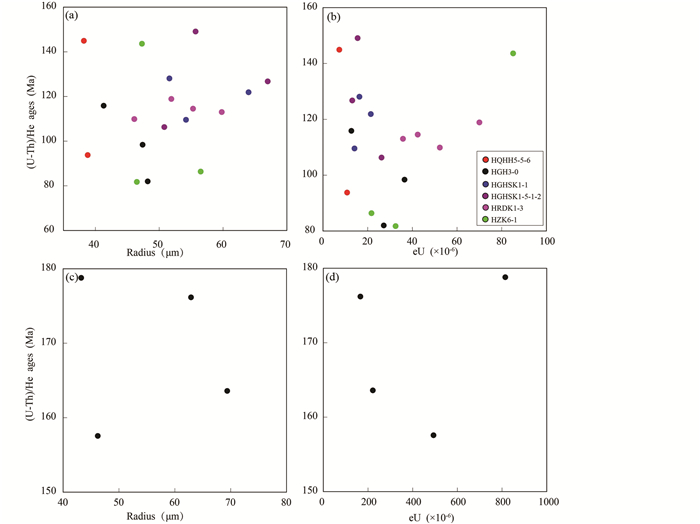
|
图 4 样品(U-Th)/He年龄与颗粒半径Rs和有效铀含量eU的关系图(a、b为磷灰石颗粒结果;c、d为锆石颗粒结果) Fig. 4 (U-Th)/He ages vs. Rs and eU from all samples (a, b, the results of apatites; c, d, the results of zircons) |
在当家寺岩体获得的两个花岗质样品的7个数据。样品HRDK1-3年龄范围从109.9±5.8Ma到118.9±6.3Ma,eU值从35.8×10-6到70.0×10-6;HZK6-1年龄范围从81.8±4.4Ma到143.6±7.6Ma,eU值从21.7×10-6到85.1×10-6。样品HRDK1-3和HZK6-1的AHe年龄与eU值表现微弱的正相关,而与颗粒半径没有明显关系。
4.2 锆石(U-Th)/He年龄来自沟后杂岩体样品(HGH3-0) 获得的4个锆石(U-Th)/He年龄(ZHe)为157.6±9.8Ma、163.6±10.1Ma、176.2±10.9Ma和178.8±11.1Ma,相应的eU分别为493.2×10-6、221.6×10-6、165.9×10-6和814.5×10-6(表 2)。所有颗粒的eU和ZHe年龄显示了微弱的负相关关系,而晶体颗粒半径和ZHe年龄之间没有明显的相关性(图 4c, d)。
|
|
表 2 共和盆地东北缘沟后杂岩体锆石(U-Th)/He测试结果 Table 2 Zircon (U-Th)/He test results for the Gouhou complex in the northeastern margin of the Gonghe basin |
共和盆地东北缘野外露头样品的磷灰石裂变径迹分析结果见表 3,包括裂变径迹年龄、径迹长度和Dpar信息。
|
|
表 3 共和盆地东北缘样品磷灰石裂变径迹测试结果 Table 3 Apatite fission track test results of samples in the northeastern margin of the Gonghe basin |
在获得的5个磷灰石裂变径迹年龄中,所有样品(HQHH5-5-6、HGHSK1-1、HGHSK1-5-1-2、HRDK1-3和HZK6-1)均通过了卡方检验(P(χ2)>5%;图 5),采用裂变径迹汇/池年龄(pooled age)(Donelick et al., 2005; Sobel et al., 2006a, b; 表 3)。
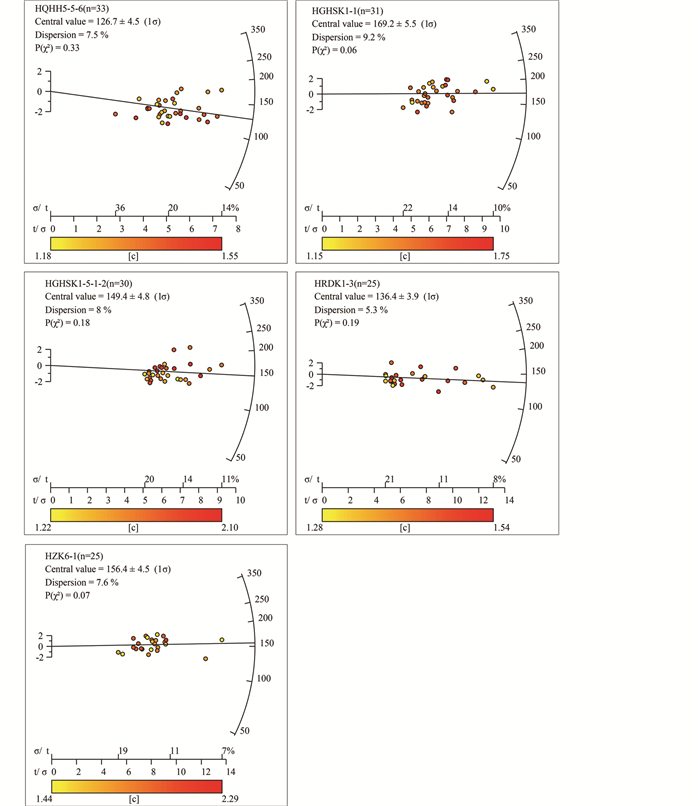
|
图 5 样品磷灰石裂变径迹年龄放射图(据Radial Plotter绘制,Vermeesch, 2009) Fig. 5 Apatite fission-track radial plots of the study samples from Radial Plotter are by Vermeesch (2009) |
共和盆地东北缘5个野外露头样品的磷灰石裂变径迹年龄主要集中在中侏罗世-早白垩世,其中沟后杂岩体为168Ma(HGHSK1-1)和148.2Ma(HGHSK1-5-1-2),当家寺岩体为154.1Ma(HZK6-1)和135.4Ma(HRDK1-3),青海南山为125.1Ma(HQHH5-5-6);Dpar值为1.37±0.09到1.78±0.21。5个样品的平均径迹长度分别为12.7548μm(HQHH5-5-6)、12.5518μm(HGHSK1-1)、12.5053μm(HGHSK1-5-1-2)、12.6936μm(HRDK1-3)和12.2656μm(样品HZK6-1)(表 3)。所有裂变径迹年龄都明显小于它们各自的结晶年龄(表 3),这表明样品结晶后冷却抬升经过了磷灰石部分退火区(Galbraith and Laslett, 1993; Gallagher et al., 1998),全部发生重置。AFT年龄可分为两组,第一组年龄为168.0~148.2Ma,中侏罗世晚期-晚侏罗世,3个样品;第二组年龄为135.4~125.1Ma,早白垩世早期,2个样品。
5 讨论 5.1 青海南山东段侏罗纪-白垩纪的多期快速隆升事件青海南山东段(青海南山、沟后杂岩体和当家寺岩体)的6个样品的低温热年代学结果(ZHe、AFT和AHe)整体可以分为三个阶段:早侏罗世晚期-早白垩世早期(178.8~143.6Ma)、早白垩世中期(135~106.3Ma)和晚白垩世中期(98.4~81.8Ma)(图 6)。
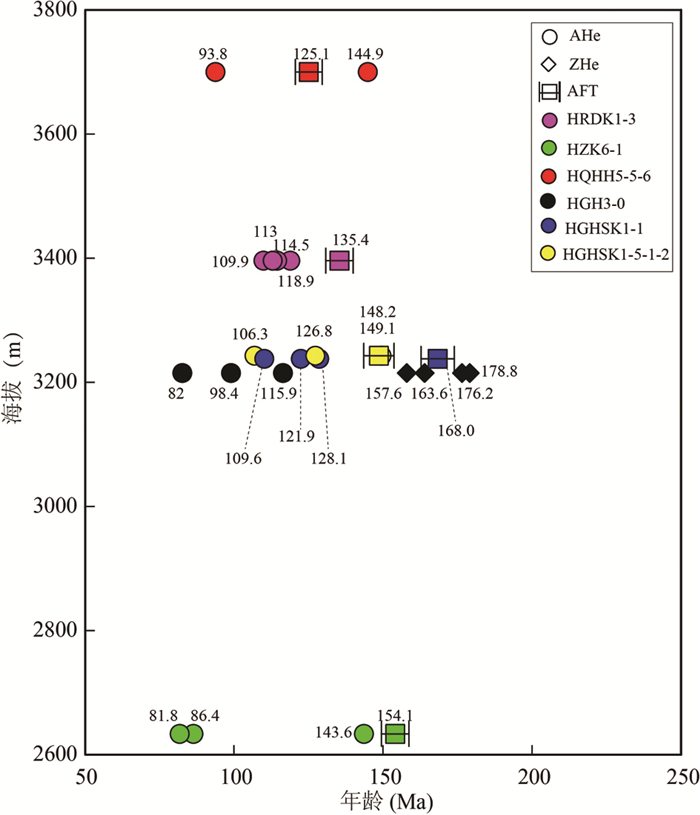
|
图 6 共和盆地东北缘样品低温热年代学年龄-海拔关系图 圆形、菱形和矩形分别表示磷灰石He、锆石He和磷灰石裂变径迹年龄,图例中的不同颜色分别表示不同的样品 Fig. 6 Relationship between age and elevation of the samples from the northeastern margin of the Gonghe basin Circles, diamonds and rectangles mark AHe, ZHe and AFT ages, respectively. Different colors in the legend mark different samples, respectively |
青海南山东段的当家寺岩体和沟后杂岩体主要由花岗闪长岩、英云闪长岩、二长花岗岩和正长花岗岩组成,偶见闪长岩包体,形成时间主要为243~236Ma和225~210Ma,存在不同时期、不同源区的侵入,与印支期青藏高原北部古特提斯洋盆的俯冲消减至碰撞转换相关(陈希节等, 2020; 贠晓瑞等, 2020)。共和县恰卜恰镇(沟后杂岩体南侧10km)钻井花岗岩岩芯的研究结果也表明岩浆结晶深度约在7.2~13.2km(贠晓瑞等, 2020)。结合此次的热年代学数据,来自沟后杂岩体黑云闪长岩HGH3-0的ZHe年龄在178.8~157.6Ma之间,较分散且明显小于结晶年龄,表明沟后杂岩体自三叠纪侵位结晶后,在早侏罗世晚期-晚侏罗世早期隆升快速通过锆石He的部分保留区(130~200℃)(Reiners et al., 2002; 喻顺等, 2019)。
AFT模拟结果显示,样品HGHSK1-1的快速冷却阶段发生在大约194~178Ma,样品HGHSK1-5-1-2的快速冷却阶段发生在大约188~162Ma,沟后杂岩体经历了早侏罗世-晚侏罗世早期的快速剥露冷却(图 7)。样品HRDK1-3的快速冷却阶段发生在大约180~150Ma,样品HZK6-1的快速冷却阶段发生在大约192~168Ma,表明当家寺岩体经历了早侏罗世-晚侏罗世的快速剥露冷却(图 7)。沟后杂岩体和当家寺岩体4个样品的磷灰石(U-Th)/He模拟结果,除沟后杂岩体样品HGHSK1-1在200~192Ma期间的快速冷却外(并未记录侏罗纪-白垩纪的冷却事件),其余3个样品均反映出研究区早白垩世的快速剥露冷却,HGHSK1-5-1-2发生120~100Ma的缓慢冷却抬升;当家寺岩体HRDK1-3和HZK6-1的快速冷却阶段则发生在124~108Ma和110~105Ma(图 8),对于青海南山北侧元古代片麻岩HQHH5-5-6的AFT和AHe联合模拟结果也指示135~114Ma的快速剥露(图 9),表明在早白垩世,共和盆地东北缘再次处于抬升时期。此外,磷灰石(U-Th)/He实测结果中98.4~81.8Ma的年龄未在模拟结果中有所体现,可能是因为该时期的剥蚀量较少,抬升量有限。
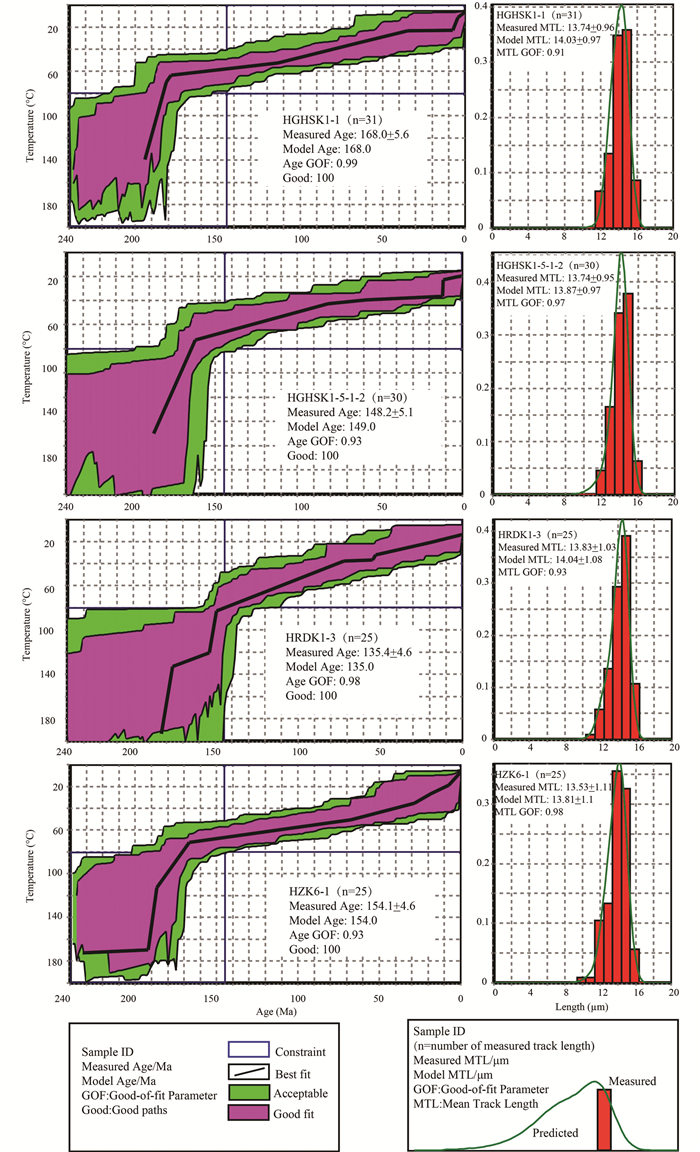
|
图 7 沟后杂岩体和当家寺岩体样品磷灰石裂变径迹模拟结果 左为时间-温度图,右为裂变径迹长度分布;在时间-温度图中,黑线是最佳拟合模型,紫色阴影对应于良好拟合范围(GOF≥0.5),绿色阴影对应于可接受拟合范围(GOF=0.05~0.5). 在裂变径迹长度图中,绿线是径迹长度分布的最佳曲线 Fig. 7 Apatite fission-track thermal histories of the study samples from the Gouhou intrusive complex and the Dangjiasi pluton Time-temperature plot results on the left and the distribution of AFT track lengths on the right. In the time temperature plot, the black line is the best-fit model, the purple shading corresponds to the range of good fits (GOF≥0.5) and the green shading corresponds to the range of acceptable fits (GOF=0.05~0.5). In the AFT track length plots, the green line is the best estimate of the AFT track lengths distribution |
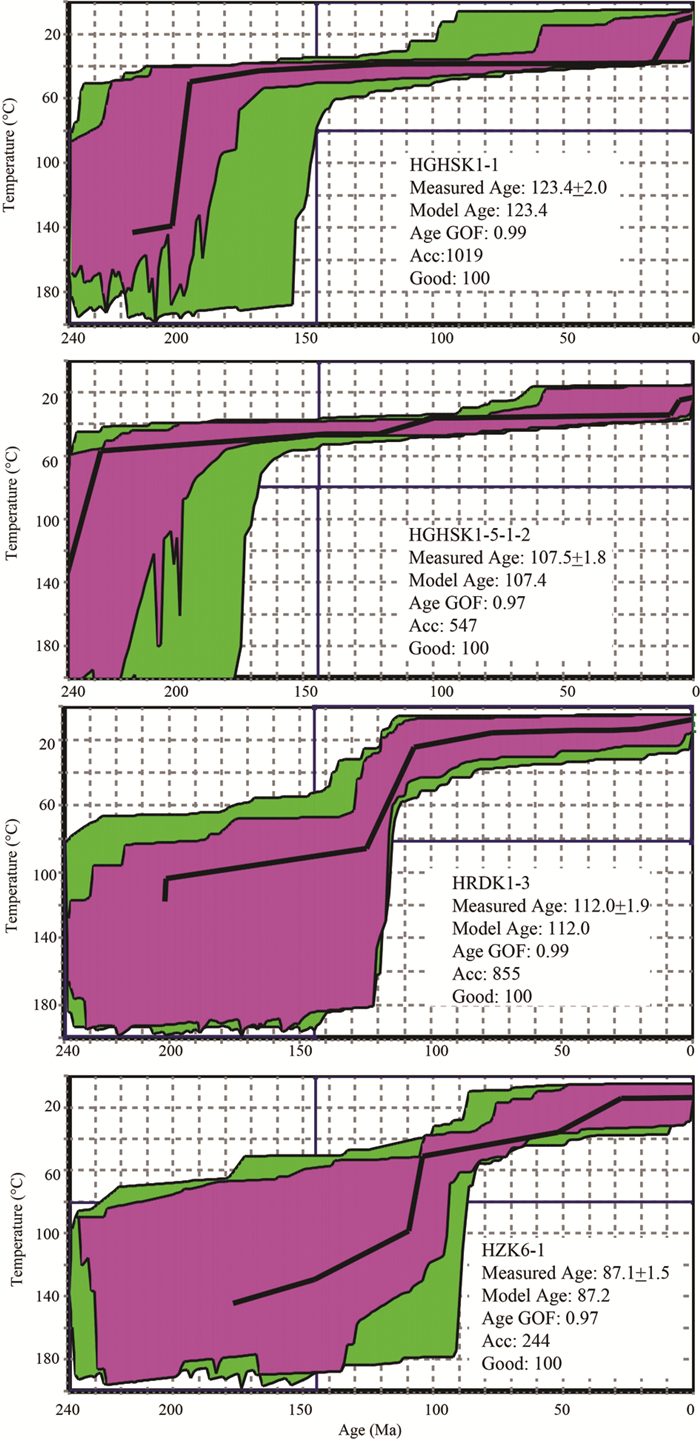
|
图 8 沟后杂岩体和当家寺岩体样品磷灰石(U-Th)/He模拟结果 Fig. 8 Apatite (U-Th)/He thermal histories for the samples from the Gouhou intrusive complex and the Dangjiasi pluton |

|
图 9 青海南山样品磷灰石裂变径迹和(U-Th)/He联合模拟结果 Fig. 9 Jointed simulation of the apatite fission-track and apatite (U-Th)/He for the samples from the Qinghai-Nan Shan |
综合模拟结果,共和盆地东北缘中生代发生200~150Ma和135~100Ma两期显著的冷却抬升,而青藏高原东北部广泛存在记录的侏罗纪-早白垩世的热年代学年龄表明该时期的隆升事件为区域性的(Mock et al., 1999; Jolivet et al., 2001; Liu et al., 2005, 2017, 2021; Duvall et al., 2013; Wang et al., 2018; Zhuang et al., 2018; Li et al., 2019; Zattin and Wang, 2019)(图 10),可能是侏罗纪-白垩纪羌塘地体和拉萨地体依次向北碰撞拼接在青藏北部的远程响应(Liu et al., 2021)。

|
图 10 青藏高原东北部侏罗纪-白垩纪低温热年代学年龄分布 图中数据来源:1-Jolivet et al., 2001; 2-Liu et al., 2005; 3-Mock et al., 1999; 4-Wang et al., 2018; 5-Liu et al., 2017; 6-Liu et al., 2021; 7-Shi et al., 2018; 8-Zhuang et al., 2018; 9-Cheng et al., 2016; 10-Jian et al., 2018; 11-Qi et al., 2016; 12-George et al., 2001; 13-He et al., 2017; 14-Pang et al., 2019; 15-He et al., 2018; 16-Li et al., 2020; 17-Craddock, 2011; 18-Wang et al., 2016a; 19-Zattin and Wang, 2019; 20-Duvall et al., 2013; 21-Li et al., 2019;22-本文 Fig. 10 The low temperature thermochronology ages of the Jurassic-Cretaceous are shown in the northeastern Tibetan Plateau |
已发表的低温热年代学数据显示青藏高原北部新生代发生了区域性隆升,在东昆仑山脉(Mock et al., 1999; Yuan et al., 2006; Clark et al., 2010; 陈宣华等, 2011; Duvall et al., 2013; 陈小宁等, 2014; Wang et al., 2017; Li et al., 2021),阿尔金山脉(Jolivet et al., 2001; Yin et al., 2002; Wang et al., 2003, 2018; Sun et al., 2005; Ritts et al., 2008; Chang et al., 2015; Cheng et al., 2015; Lin et al., 2015; Li et al., 2017; Liu et al., 2017),祁连山脉(Song et al., 2001; 陈杰等, 2006; Bovet et al., 2009; Palumbo et al., 2009; Zheng et al., 2010; Liu et al., 2011; Duvall et al., 2013; Wang et al., 2016a, b, 2018; Zhuang et al., 2018; Yu et al., 2019; Li et al., 2020; Wu et al., 2021)都有古近纪和中新世的低温热年代学年龄记录(图 11)。
北祁连山脉热年代学年龄显示的中新世快速冷却阶段有20~10Ma(George et al., 2001; Bovet et al., 2009)、17~15Ma(Yu et al., 2019)、17~12Ma(Duvall et al., 2013)、~16Ma(Wang et al., 2016a, b)、~10Ma(Zheng et al., 2010; Zhuang et al., 2018)、~4.5Ma(Zhao et al., 2001)、~4Ma(Palumbo et al., 2009; Liu et al., 2011; Wang et al., 2018)、4~3Ma(Song et al., 2001; 陈杰等, 2006)。南祁连山脉和柴达木盆地北缘的热年代学年龄显示的中新世快速冷却阶段有17~12Ma(Zhuang et al., 2018)、~14.7Ma(Fang et al., 2007)、~12Ma(Wang et al., 2017)。在共和盆地西部的鄂拉山则记录到17~12Ma的快速冷却阶段(Duvall et al., 2013);共和盆地东部的拉脊山记录到~22Ma和~13Ma的快速冷却阶段(Lease et al., 2011);贵德盆地、循化盆地和临夏盆地则分别记录到17~11Ma(Yan et al., 2006)、~22Ma(Lease et al., 2012)和~14Ma(Fang et al., 2003; Garzione et al., 2005; Hough et al., 2011)的快速冷却阶段。而位于祁连山-海原断裂最东端的六盘山和寺口子则分别记录到~8Ma(Zheng et al., 2006)和~11Ma(Wang et al., 2011)的快速冷却阶段。关于中新世之后的青藏高原北部构造变形、山脉隆升和断裂启动的动力学机制。有的学者根据西藏中部新生代火山岩较高的La/Yb值和柴达木盆地中新世的快速缩短认为是由地壳增厚引起的(Zhou et al., 2006; Liu et al., 2009, 2021; Chen et al., 2018)。对祁连山脉新近纪的阶段性扩展和南北两侧的同步变形研究,认为青藏高原的整体或部分的地幔岩石圈移除(mantle remove)可能为启动祁连山向外扩张的主要驱动力(Molnar and Stock, 2009; Pang et al., 2019)。
本文研究区位于共和盆地北部,青海南山东段的沟后杂岩体,其AFT模拟结果也记录到晚中新世(12~5Ma)的快速剥露冷却(图 7),其中样品HGHSK1-1新生代快速冷却阶段发生在大约9~5Ma,样品HGHSK1-5-1-2的快速冷却阶段发生在大约12~10Ma。AHe模拟同样记录到该时期的冷却抬升,样品HGHSK1-1和HGHSK1-5-1-2的快速冷却阶段分别为15~7Ma和9~5Ma(图 8)。AFT和AHe模拟所记录到的晚中新世的快速冷却指示青海南山东段在沟后地区的隆升时间,此年龄与前人研究的青海南山断裂的再启动时间一致(11~9Ma)(Craddock et al., 2014)。此时期的冷却事件并未在当家寺岩体中有所体现。
青海湖盆地和共和盆地地层变形特征及构造地质学系统研究表明青海南山隆起发生于上新世(Wang and Burchfiel, 2004; 常宏等, 2009)或晚中新世(Zhang et al., 2012),而本研究共和盆地东部当家寺岩体的样品并未记录到新近纪的快速冷却事件,而是自早白垩世以来的缓慢冷却。这可能是逆冲为主的青海南山南缘左行逆冲走滑断裂晚新生代再活动使得沟后杂岩体在中新世的隆升,而盆地东部的当家寺岩体主要受瓦里贡断裂(右行走滑)的控制,并未发生该时期的快速隆升。
综合共和盆地东北缘青海南山东、沟后杂岩体、当家寺岩体露头样品的热演化过程(图 12),该区早侏罗世晚期以来主要经历过3期快速隆升,其中,中生代(200~100Ma)有两期快速冷却抬升,晚中新世(15~5Ma)再次出现差异的快速冷却抬升。研究也显示,沟后杂岩体和当家寺岩体露头区样品结晶后未经历明显的增热现象,与共和盆地内干热岩存在的中新世晚期增热特征不同(贠晓瑞等,未发表资料)。
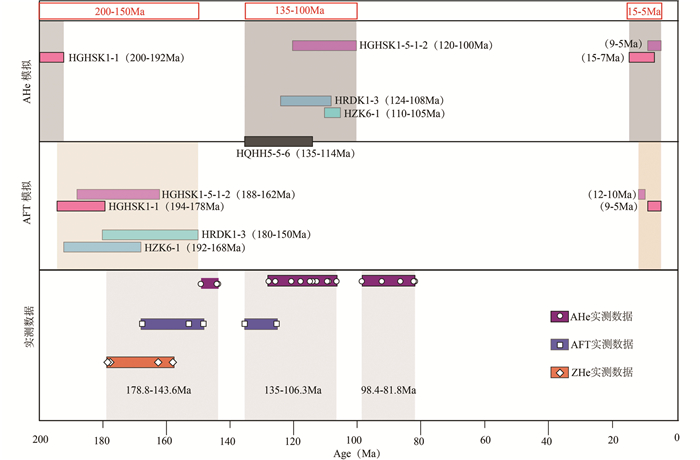
|
图 12 共和盆地东北缘露头区经历的热历史过程 Fig. 12 Comprehensive thermal history of the outcrop sections in the northeastern margin of the Gonghe basin |
(1) 共和盆地东北缘自三叠纪结晶以来,在侏罗纪-白垩纪,经历200~150Ma和135~100Ma两期快速冷却抬升,是羌塘地体和拉萨地体依次向北碰撞拼接在青藏高原东北部的远程效应。
(2) 共和盆地东北缘沟后杂岩体记录到晚中新世(15~5Ma)发生过快速冷却事件,而当家寺岩体未记录到该期的快速冷却事件,可能受控于该时期具有不同性质的青海南山断裂、瓦里贡断裂差异活动的影响。
(3) 共和盆地东北缘热演化过程表明早侏罗世以来主要经历过3期快速隆升,但露头岩体热历史过程未见到明显的中新世以来的增热现象,与共和盆地内干热岩存在的增热特征不同。
致谢 感谢李广伟教授、焦存礼高级工程师、喻顺副研究员、马绪宣副研究员的建议和帮助。感谢张智勇研究员、张二勇研究员、严维德教授级高级工程师、李旭峰高级工程师对本研究的支持。感谢墨尔本大学地球科学学院Barry Kohn教授对锆石(U-Th)/He、中国科学院地质与地球物理研究所吴林高级工程师对磷灰石(U-Th)/He以及张志勇副研究员对磷灰石裂变径迹等的分析测试和建议。感谢两位审稿专家及俞良军副主编建设性的意见。
An ZS, Kutzbach JE, Prell WL and Porter SC. 2001. Evolution of Asian monsoons and phased uplift of the Himalaya-Tibetan Plateau since Late Miocene times. Nature, 411(6833): 62-66 DOI:10.1038/35075035
|
Bovet PM, Ritts BD, Gehrels G, Abbink AO, Darby B and Hourigan J. 2009. Evidence of Miocene crustal shortening in the North Qilian Shan from Cenozoic stratigraphy of the western Hexi Corridor, Gansu Province, China. American Journal of Science, 309(4): 290-329 DOI:10.2475/00.4009.02
|
Braun J. 2002. Quantifying the effect of recent relief changes on age-elevation relationships. Earth and Planetary Science Letters, 200(3-4): 331-343 DOI:10.1016/S0012-821X(02)00638-6
|
Chang H, Jin ZD and An ZS. 2009. Sedimentary evidence of the uplift of the Qinghai Nanshan (the mountains south to Qinghai Lake) and its implication for structural evolution of the Lake Qinghai-Gonghe Basin. Geological Review, 55(1): 49-57 (in Chinese with English abstract)
|
Chang H, Li LY, Qiang XK, Garzione CN, Pullen A and An ZS. 2015. Magnetostratigraphy of Cenozoic deposits in the western Qaidam Basin and its implication for the surface uplift of the northeastern margin of the Tibetan Plateau. Earth and Planetary Science Letters, 430: 271-283 DOI:10.1016/j.epsl.2015.08.029
|
Chen J, Wyrwoll KH, Lu YC, Krapez B, Wan JL and Liu JF. 2006. Magnetochronology of the Yumen conglomerates and multi-pulsed folding and thrusting in the northern Qilianshan. Quaternary Sciences, 26(1): 20-31 (in Chinese with English abstract)
|
Chen JL, Yin A, Xu JF, Dong YH and Kang ZQ. 2018. Late Cenozoic magmatic inflation, crustal thickening, and >2km of surface uplift in Central Tibet. Geology, 46(1): 19-22 DOI:10.1130/G39699.1
|
Chen XH, Mcrivette MW, Li L, Yin A, Jiang RB, Wan JL and Li HJ. 2011. Thermochronological evidence for multi-phase uplifting of the East Kunlun Mountains, northern Tibetan Plateau. Geological Bulletin of China, 30(11): 1647-1660 (in Chinese with English abstract)
|
Chen XJ, Yun XR, Lei M, Cai ZH, Zhang SS, Liu RH, Li YB and He BZ. 2020. Petrogenesis of Middle Triassic granite association in the Gonghe basin, Qinghai: Constraints from geochemistry, U-Pb ages and Hf isotopic. Acta Petrologica Sinica, 36(10): 3152-3170 (in Chinese with English abstract) DOI:10.18654/1000-0569/2020.10.13
|
Chen XN, Yuan WM, Zhang AK, Hao NN, Duan HW and Feng YL. 2014. Apatite fission track analysis for revealing tectonic events of the Bayinguole area in the west section of Eastern Kunlun Mountains, northern Qinghai-Tibet Plateau. Nuclear Techniques, 37(1): 54-61 (in Chinese with English abstract)
|
Cheng F, Guo ZJ, Jenkins HS, Fu ST and Cheng X. 2015. Initial rupture and displacement on the Altyn Tagh fault, northern Tibetan Plateau: Constraints based on residual Mesozoic to Cenozoic strata in the western Qaidam Basin. Geosphere, 11(3): 921-942 DOI:10.1130/GES01070.1
|
Cheng F, Garzione C, Jolivet M, Wang WT, Dong JB, Richter F and Guo ZJ. 2019. Provenance analysis of the Yumen Basin and northern Qilian Shan: Implications for the pre-collisional paleogeography in the NE Tibetan Plateau and eastern termination of Altyn Tagh fault. Gondwana Research, 65: 156-171 DOI:10.1016/j.gr.2018.08.009
|
Cheng F, Zuza AV, Haproff PJ, Wu C, Neudorf C, Chang H, Li ZX and Li B. 2021. Accommodation of India-Asia convergence via strike-slip faulting and block rotation in the Qilian Shan fold-thrust belt, northern margin of the Tibetan Plateau. Journal of the Geological Society, 178(3): igs2020-207 DOI:10.1144/jgs2020-207
|
Cheng XG, Lin XB, Wu L, Chen HL, Xiao AN, Gong JF, Zhang FQ and Yang SF. 2016. The exhumation history of North Qaidam Thrust Belt constrained by apatite fission track thermochronology: implication for the evolution of the Tibetan Plateau. Acta Geologica Sinica, 90(3): 870-883 DOI:10.1111/1755-6724.12730
|
Clark MK, Farley KA, Zheng DW, Wang ZC and Duvall AR. 2010. Early Cenozoic faulting of the northern Tibetan Plateau margin from apatite (U-Th)/He ages. Earth and Planetary Science Letters, 296(1-2): 78-88 DOI:10.1016/j.epsl.2010.04.051
|
Clark MK. 2012. Continental collision slowing due to viscous mantle lithosphere rather than topography. Nature, 483(7387): 74-77 DOI:10.1038/nature10848
|
Craddock WH. 2011. Structural and geomorphic evolution of the Gonghe Basin Complex, northeastern Tibet: Implications for the timing of plateau growth. Ph. D. Dissertation. Ann Arbor: The Pennsylvania State University, 1-27
|
Craddock WH, Kirby E, Zhang HP, Clark MK, Champagnac JD and Yuan DY. 2014. Rates and style of Cenozoic deformation around the Gonghe Basin, northeastern Tibetan Plateau. Geosphere, 10(6): 1255-1282 DOI:10.1130/GES01024.1
|
Dai S, Fang XM, Dupont-Nivet G, Song CH, Gao JP, Krijgsman W, Langereis C and Zhang WL. 2006. Magnetostratigraphy of Cenozoic sediments from the Xining Basin: Tectonic implications for the northeastern Tibetan Plateau. Journal of Geophysical Research: Solid Earth, 111(B11): B11102
|
Ding L, Spicer RA, Yang J, Xu Q, Cai FL, Li S, Lai QZ, Wang HQ, Spicer TEV, Yue YH, Shukla A, Srivastava G, Khan MA, Bera S and Mehrotra R. 2017. Quantifying the rise of the Himalaya orogen and implications for the South Asian monsoon. Geology, 45(3): 215-218 DOI:10.1130/G38583.1
|
Donelick RA, O'Sullivan PB and Ketcham RA. 2005. Apatite fission-track analysis. Reviews in Mineralogy and Geochemistry, 58(1): 49-94 DOI:10.2138/rmg.2005.58.3
|
Dupont-Nivet G, Horton BK, Butler RF, Wang J, Zhou J and Waanders GL. 2004. Paleogene clockwise tectonic rotation of the Xining-Lanzhou region, northeastern Tibetan Plateau. Journal of Geophysical Research: Solid Earth, 109(B4): B04401
|
Duvall AR, Clark MK, van der Pluijm BA and Li CY. 2011. Direct dating of Eocene reverse faulting in north-eastern Tibet using Ar-dating of fault clays and low-temperature thermochronometry. Earth and Planetary Science Letters, 304(3-4): 520-526 DOI:10.1016/j.epsl.2011.02.028
|
Duvall AR, Clark MK, Kirby E, Farley KA, Craddock WH, Li CY and Yuan DY. 2013. Low-temperature thermochronometry along the Kunlun and Haiyuan Faults, NE Tibetan Plateau: Evidence for kinematic change during late-stage orogenesis. Tectonics, 32(5): 1190-1211 DOI:10.1002/tect.20072
|
Fang XM, Garzione C, Vander Voo R, Li JJ and Fan MJ. 2003. Flexural subsidence by 29Ma on the NE edge of Tibet from the magneto stratigraphy of Linxia Basin, China. Earth and Planetary Science Letters, 210(3-4): 545-560 DOI:10.1016/S0012-821X(03)00142-0
|
Fang XM, Zhang WL, Meng QQ, Gao JP, Wang XM, King J, Song CH, Dai S and Miao YF. 2007. High-resolution magnetostratigraphy of the Neogene Huaitoutala section in the eastern Qaidam Basin on the NE Tibetan Plateau, Qinghai Province, China and its implication on tectonic uplift of the NE Tibetan Plateau. Earth and Planetary Science Letters, 258(1-2): 293-306 DOI:10.1016/j.epsl.2007.03.042
|
Farley KA, Wolf RA and Silver LT. 1996. The effects of long alpha-stopping distances on (U-Th)/He ages. Geochimica et Cosmochimica Acta, 60(21): 4223-4229 DOI:10.1016/S0016-7037(96)00193-7
|
Feng YF, Zhang XX, Zhang B, Liu JT, Wang YG, Jia DL, Hao LR and Kong ZY. 2018. The geothermal formation mechanism in the Gonghe Basin: Discussion and analysis from the geological background. China Geology, 1(3): 331-345 DOI:10.31035/cg2018043
|
Fox M and Shuster DL. 2014. The influence of burial heating on the (U-Th)/He system in apatite: Grand Canyon case study. Earth and Planetary Science Letters, 397: 174-183 DOI:10.1016/j.epsl.2014.04.041
|
Galbraith RF and Laslett GM. 1993. Statistical models for mixed fission track ages. Nuclear Tracks and Radiation Measurements, 21(4): 459-470 DOI:10.1016/1359-0189(93)90185-C
|
Gallagher K, Brown R and Johnson C. 1998. Fission track analysis and its applications to geological problems. Annual Review of Earth and Planetary Sciences, 26: 519-572 DOI:10.1146/annurev.earth.26.1.519
|
Garzione CN, Ikari MJ and Basu AR. 2005. Source of Oligocene to Pliocene sedimentary rocks in the Linxia basin in northeastern Tibet from Nd isotopes: Implications for tectonic forcing of climate. GSA Bulletin, 117(9-10): 1156-1166
|
Gautheron C, Tassan-Got L, Barbarand J and Pagel M. 2009. Effect of alpha-damage annealing on apatite (U-Th)/He thermochronology. Chemical Geology, 266(3-4): 157-170 DOI:10.1016/j.chemgeo.2009.06.001
|
George AD, Marshallsea SJ, Wyrwoll KH, Chen J and Lu YC. 2001. Miocene cooling in the northern Qilian Shan, northeastern margin of the Tibetan Plateau, revealed by apatite fission-track and vitrinite-reflectance analysis. Geology, 29(10): 939-942 DOI:10.1130/0091-7613(2001)029<0939:MCITNQ>2.0.CO;2
|
Gleadow A, Harrison M, Kohn B, Lugo-Zazueta R and Phillips D. 2015. The Fish Canyon Tuff: A new look at an old low-temperature thermochronology standard. Earth and Planetary Science Letters, 424: 95-108 DOI:10.1016/j.epsl.2015.05.003
|
Gleadow AJW and Duddy IR. 1981. A natural long-term track annealing experiment for apatite. Nuclear Tracks, 5(1-2): 169-174 DOI:10.1016/0191-278X(81)90039-1
|
Gleadow AJW, Belton DX, Kohn BP and Brown RW. 2002. Fission track dating of phosphate minerals and the thermochronology of apatite. Reviews in Mineralogy and Geochemistry, 48(1): 579-630 DOI:10.2138/rmg.2002.48.16
|
Gleadow AJW, Gleadow SJ, Belton DX, Kohn BP and Krochmal MS. 2009. Coincidence mapping: A key strategy for automated counting in fission track dating. In: Lisker F, Ventura B and Glasmacher UA (eds.). Thermochronological Methods: From Palaeotemperature Constraints to Landscape Evolution Models, Geological Society of London Special Publication, 25-36
|
Guo AL, Zhang GW, Sun YG, Cheng SY and Qiang J. 2007. Sr-Nd-Pb isotopic geochemistry of Late-Paleozoic mafic volcanic rocks in the surrounding areas of the Gonghe basin, Qinghai Province and geological implications. Acta Petrologica Sinica, 23(4): 747-754 (in Chinese with English abstract)
|
Guo XQ, Yan Z, Fu CL and Wang ZQ. 2016. Formation age and tectonic attribute of Jinshuikou Group complex in the Nanshan area, Qinghai. Acta Geologica Sinica, 90(3): 589-606 (in Chinese with English abstract)
|
Hasebe N, Barbarand J, Jarvis K, Carter A and Hurford AJ. 2004. Apatite fission-track chronometry using laser ablation ICP-MS. Chemical Geology, 207(3-4): 135-145 DOI:10.1016/j.chemgeo.2004.01.007
|
He PJ, Song CH, Wang YD, Chen LH, Chang PF, Wang QQ and Ren B. 2017. Cenozoic exhumation in the Qilian Shan, northeastern Tibetan Plateau: Evidence from detrital fission-track thermochronology in the Jiuquan Basin. Journal of Geophysical Research: Solid Earth, 122(8): 6910-6927 DOI:10.1002/2017JB014216
|
He PJ, Song CH, Wang YD, Meng QQ, Chen LH, Yao LJ, Huang RH, Feng W and Chen S. 2018. Cenozoic deformation history of the Qilian Shan (northeastern Tibetan Plateau) constrained by detrital apatite fission-track thermochronology in the northeastern Qaidam Basin. Tectonophysics, 749: 1-11 DOI:10.1016/j.tecto.2018.10.017
|
Horton BK, Dupont-Nivet G, Zhou J, Waanders GL, Butler RF and Wang J. 2004. Mesozoic-Cenozoic evolution of the Xining-Minhe and Dangchang basins, northeastern Tibetan Plateau: magnetostratigraphic and biostratigraphic results. Journal of Geophysical Research: Solid Earth, 109(B4): B04402
|
Hough BG, Garzione CN, Wang ZC, Lease RO, Burbank DW and Yuan DY. 2011. Stable isotope evidence for topographic growth and basin segmentation: Implications for the evolution of the NE Tibetan Plateau. GSA Bulletin, 123(1-2): 168-185 DOI:10.1130/B30090.1
|
Jian X, Guan P, Zhang W, Liang HH, Feng F and Fu L. 2018. Late Cretaceous to Early Eocene deformation in the northern Tibetan Plateau: Detrital apatite fission track evidence from northern Qaidam basin. Gondwana Research, 60: 94-104 DOI:10.1016/j.gr.2018.04.007
|
Jiang CF, Wang ZQ and Li JY. 2000. Opening-Closing Tectonics of Central Orgenic Belt. Beijing: Geological Publishing House, 1-107 (in Chinese)
|
Jolivet M, Brunel M, Seward D, Xu Z, Yang J, Roger F, Tapponnier P, Malavieille J, Arnaud N and Wu C. 2001. Mesozoic and Cenozoic tectonics of the northern edge of the Tibetan Plateau: Fission-track constraints. Tectonophysics, 343(1-2): 111-134 DOI:10.1016/S0040-1951(01)00196-2
|
Ketcham RA, Carter A, Donelick RA, Barbarand J and Hurford AJ. 2007. Improved modeling of fission-track annealing in apatite. American Mineralogist, 92(5-6): 799-810 DOI:10.2138/am.2007.2281
|
Lease RO, Burbank DW, Clark MK, Farley KA, Zheng DW and Zhang HP. 2011. Middle Miocene reorganization of deformation along the northeastern Tibetan Plateau. Geology, 39(4): 359-362 DOI:10.1130/G31356.1
|
Lease RO, Burbank DW, Hough B, Wang ZC and Yuan DY. 2012. Pulsed Miocene range growth in northeastern Tibet: Insights from Xunhua Basin magnetostratigraphy and provenance. GSA Bulletin, 124(5-6): 657-677 DOI:10.1130/B30524.1
|
Li B, Chen XH, Zuza AV, Hu DG, Ding WC, Huang PH and Xu SL. 2019. Cenozoic cooling history of the North Qilian Shan, northern Tibetan Plateau, and the initiation of the Haiyuan fault: Constraints from apatite- and zircon-fission track thermochronology. Tectonophysics, 751: 109-124 DOI:10.1016/j.tecto.2018.12.005
|
Li B, Zuza AV, Chen XH, Hu DG, Shao ZG, Qi BS, Wang ZZ, Levy DA and Xiong XS. 2020. Cenozoic multi-phase deformation in the Qilian Shan and out-of-sequence development of the northern Tibetan Plateau. Tectonophysics, 782-783: 228423 DOI:10.1016/j.tecto.2020.228423
|
Li CP, Zheng DW, Zhou RJ, Yu JX, Wang YZ, Pang JZ, Wang Y, Hao YQ and Li YJ. 2021. Late Oligocene tectonic uplift of the East Kunlun Shan: Expansion of the northeastern Tibetan Plateau. Geophysical Research Letters, 48(3): e2020GL091281
|
Li GW. 2021. A brief review of key issues in tectonic geomorphology and low temperature thermochronology applications. Acta Geologica Sinica, 95(1): 214-226 (in Chinese with English abstract)
|
Li JY and Zhang J. 2015. Large-Scale Deformation Map of China (1:2500000). Beijing: Geological Publishing House, 1-50 (in Chinese)
|
Li RB, Pei XZ, Yang SH, Wang WF, Wei LY, Sun Y, Li F, Liu MN and Zhao CC. 2016. LA-ICP-MS zircon age of metamorphism rocks in the Rouqigang area of western Gonghe Basin: Maximum depositional ages of protoliths and provenance feature. Acta Geologica Sinica, 90(1): 93-114 (in Chinese with English abstract)
|
Li S, Ding L, Guilmette C, Fu JJ, Xu Q, Yue YH and Henrique-Pinto R. 2017. The subduction-accretion history of the Bangong-Nujiang Ocean: Constraints from provenance and geochronology of the Mesozoic strata near Gaize, Central Tibet. Tectonophysics, 702: 42-60 DOI:10.1016/j.tecto.2017.02.023
|
Lin X, Zheng DW, Sun JM, Windley BF, Tian ZH, Gong ZJ and Jia YY. 2015. Detrital apatite fission track evidence for provenance change in the Subei Basin and implications for the tectonic uplift of the Danghenan Shan (NW China) since the mid-Miocene. Journal of Asian Earth Sciences, 111: 302-311 DOI:10.1016/j.jseaes.2015.07.007
|
Lin X, Jolivet M, Liu-Zeng J, Cheng F, Tian YT and Li CA. 2021. Mesozoic-Cenozoic cooling history of the eastern Qinghai Nan Shan (NW China): Apatite low-temperature thermochronology constraints. Palaeogeography, Palaeoclimatology, Palaeoecology, 572: 110416 DOI:10.1016/j.palaeo.2021.110416
|
Liu DL, Fang XM, Gao JP, Wang YD, Zhang WL, Miao YF, Liu YQ and Zhang YZ. 2009. Cenozoic stratigraphy deformation history in the central and eastern of Qaidam Basin by the balance section restoration and its implication. Acta Geological Sinica, 83(2): 359-371 DOI:10.1111/j.1755-6724.2009.00024.x
|
Liu DL, Yan MD, Fang XM, Li HB, Song CH and Dai S. 2011. Magneto stratigraphy of sediments from the Yumu Shan, Hexi Corridor and its implications regarding the Late Cenozoic uplift of the NE Tibetan Plateau. Quaternary International, 236(1-2): 13-20 DOI:10.1016/j.quaint.2010.12.007
|
Liu DL, Li HB, Sun ZM, Pan JW, Wang M, Wang H and Chevalier ML. 2017. AFT dating constrains the Cenozoic uplift of the Qimen Tagh Mountains, Northeast Tibetan Plateau, comparison with LA-ICPMS zircon U-Pb ages. Gondwana Research, 41: 438-450 DOI:10.1016/j.gr.2015.10.008
|
Liu DL, Li HB, Chevalier ML, Sun ZM, Pei JL, Pan JW, Ge CL, Wang P, Wang H and Wu C. 2021. Activity of the Baiganhu fault of the Altyn Tagh fault system, northern Tibetan Plateau: Insights from zircon and apatite fission track analyses. Palaeogeography, Palaeoclimatology, Palaeoecology, 570: 110356 DOI:10.1016/j.palaeo.2021.110356
|
Liu YJ, Genser J, Neubauer F, Jin W, Ge XH, Handler R and Takasu A. 2005. 40Ar/39Ar mineral ages from basement rocks in the Eastern Kunlun Mountains, NW China, and their tectonic implications. Tectonophysics, 398(3-4): 199-224 DOI:10.1016/j.tecto.2005.02.007
|
Mock C, Arnaud NO and Cantagrel JM. 1999. An early unroofing in northeastern Tibet? Constraints from 40Ar/39Ar thermochronology on granitoids from the eastern Kunlun range (Qianghai, NW China). Earth and Planetary Science Letters, 171(1): 107-122 DOI:10.1016/S0012-821X(99)00133-8
|
Molnar P. 2005. Mio-Pliocene growth of the Tibetan Plateau and evolution of East Asian climate. Palaeontologia Electronica, 8(1): 1-23
|
Molnar P and Stock JM. 2009. Slowing of India's convergence with Eurasia since 20 Ma and its implications for Tibetan mantle dynamics. Tectonics, 28(3): TC3001
|
Palumbo L, Hetzel R, Tao MX, Li XB and Guo JM. 2009. Deciphering the rate of mountain growth during topographic presteady state: An example from the NE margin of the Tibetan Plateau. Tectonics, 28(4): TC4017
|
Pang JZ, Yu JX, Zheng DW, Wang WT, Ma Y, Wang YZ, Li CP, Li YJ and Wang Y. 2019. Neogene expansion of the Qilian Shan, North Tibet: Implications for the dynamic evolution of the Tibetan Plateau. Tectonics, 38(3): 1018-1032 DOI:10.1029/2018TC005258
|
Qi BS, Hu DG, Yang XX, Zhang YL, Tan CX, Zhang P and Feng CJ. 2016. Apatite fission track evidence for the Cretaceous-Cenozoic cooling history of the Qilian Shan (NW China) and for stepwise northeastward growth of the northeastern Tibetan Plateau since Early Eocene. Journal of Asian Earth Sciences, 124: 28-41 DOI:10.1016/j.jseaes.2016.04.009
|
Reiners PW, Farley KA and Hickes HJ. 2002. He diffusion and (U-Th)/He thermochronometry of zircon: Initial results from Fish Canyon Tuff and Gold Butte. Tectonophysics, 349(1-4): 297-308 DOI:10.1016/S0040-1951(02)00058-6
|
Reiners PW and Shuster DL. 2009. Thermochronology and landscape evolution. Physics Today, 62(9): 31-36 DOI:10.1063/1.3226750
|
Ritts BD, Yue YJ, Graham SA, Sobel ER, Abbink OA and Stockli D. 2008. From sea level to high elevation in 15 million years: Uplift history of the northern Tibetan Plateau margin in the Altun Shan. American Journal of Science, 308(5): 657-678 DOI:10.2475/05.2008.01
|
Shi BY and Zhang JT. 1982. Discussion on Gonghe gap in Qin-Kun tectonic belt. Qinghai Geology, (3): 20-29 (in Chinese)
|
Shi W, Ma YS, Wu ML, Zhang YF and Du DP. 2006. Quaternary magnetostratigraphy of the Gonghe Basin on the northeastern of the Qinghai-Tibetan Plateau. Journal of Geomechanics, 12(3): 317-323 (in Chinese with English abstract)
|
Shi WB, Wang F, Yang LK, Wu L and Zhang WB. 2018. Diachronous growth of the Altyn Tagh Mountains: Constraints on propagation of the northern Tibetan margin from (U-Th)/He dating. Journal of Geophysical Research: Solid Earth, 123(7): 6000-6018 DOI:10.1029/2017JB014844
|
Shi YL, Huo Q, Pan X, Tian T and Li SH. 2018. LA-ICP-MS zircon U-Pb age of the intrusive rocks in Longyangxia area of Qinghai Province and its geological significance. Geological Bulletin of China, 37(7): 1246-1257 (in Chinese with English abstract)
|
Sobel ER, Chen J and Heermance RV. 2006a. Late Oligocene-Early Miocene initiation of shortening in the southwestern Chinese Tian Shan: Implications for Neogene shortening rate variations. Earth and Planetary Science Letters, 247: 70-81 DOI:10.1016/j.epsl.2006.03.048
|
Sobel ER, Oskin M, Burbank D and Miskolaichuk A. 2006b. Exhumation of basement-cored uplifts: Example of the Kyrgyz range quantified with apatite fission track thermochronology. Tectonics, 25(2): TC2008
|
Song CH, Fang XM, Li JJ, Gao JP, Zhao ZJ and Fan MJ. 2001. Tectonic uplift and sedimentary evolution of the Jiuxi Basin in the northern margin of the Tibetan Plateau since 13Ma BP. Science in China (Series D), 44(S1): 192-202 DOI:10.1007/BF02911987
|
Sun JM, Zhu RX and An ZS. 2005. Tectonic uplift in the northern Tibetan Plateau since 13.7Ma ago inferred from molasse deposits along the Altyn Tagh Fault. Earth and Planetary Science Letters, 235(3-4): 641-653 DOI:10.1016/j.epsl.2005.04.034
|
Sun ZX, Li BX and Wang ZL. 2011. Exploration of the possibility of hot dry rock occurring in the Qinghai Gonghe Basin. Hydrogeology and Engineering Geology, 38(2): 119-124, 129 (in Chinese with English abstract)
|
Tapponnier P, Xu ZQ, Roger F, Meyer B, Arnaud N, Wittlinger G and Yang JS. 2001. Oblique stepwise rise and growth of the Tibet Plateau. Science, 294(5547): 1671-1677 DOI:10.1126/science.105978
|
Vermeesch P. 2009. Radial Plotter: A Java application for fission track, luminescence and other radial plots. Radiation Measurements, 44(4): 409-410 DOI:10.1016/j.radmeas.2009.05.003
|
Vermeesch P. 2010. Helioplot, and the treatment of overdispersed (U-Th-Sm)/He data. Chemical Geology, 271(3-4): 108-111 DOI:10.1016/j.chemgeo.2010.01.002
|
Wang CG and Lü YS. 2004. Gonghe basin: A new and worth-researching basin. Xinjiang petroleum Geology, 25(5): 471-473 (in Chinese with English abstract)
|
Wang CS, Dai JG, Zhao XX, Li YL, Graham SA, He DF, Ran B and Meng J. 2014. Outward-growth of the Tibetan Plateau during the Cenozoic: A review. Tectonophysics, 621: 1-43 DOI:10.1016/j.tecto.2014.01.036
|
Wang ECE and Burchfiel BC. 2004. Late Cenozoic right-lateral movement along the Wenquan fault and associated deformation: Implications for the kinematic history of the Qaidam Basin, Northeastern Tibetan Plateau. International Geology Review, 46(10): 861-879 DOI:10.2747/0020-6814.46.10.861
|
Wang H, Wang CH, Gao GY, Chen N, Zhou H and An YF. 2021. The state of the in-situ stress and fault slide evaluation of Gonghe Basin, Qinghai Province. Technology for Earthquake Disaster Prevention, 16(1): 123-133 (in Chinese with English abstract)
|
Wang WT, Zhang PZ, Kirby E, Wang LH, Zhang GL, Zheng DW and Chai CZ. 2011. A revised chronology for Tertiary sedimentation in the Sikouzi basin: Implications for the tectonic evolution of the northeastern corner of the Tibetan Plateau. Tectonophysics, 505(1-4): 100-114 DOI:10.1016/j.tecto.2011.04.006
|
Wang WT, Zhang PZ, Pang JZ, Garzione C, Zhang HP, Liu CC, Zheng DW, Zheng WJ and Yu JX. 2016a. The Cenozoic growth of the Qilian Shan in the northeastern Tibetan Plateau: A sedimentary archive from the Jiuxi Basin. Journal of Geophysical Research: Solid Earth, 121(4): 2235-2257 DOI:10.1002/2015JB012689
|
Wang XM, Wang BY, Qiu ZX, Xie GP, Xie JY, Downs W, Qiu ZD and Deng T. 2003. Danghe area (western Gansu, China) biostratigraphy and implications for depositional history and tectonics of northern Tibetan Plateau. Earth and Planetary Science Letters, 208(3-4): 253-269 DOI:10.1016/S0012-821X(03)00047-5
|
Wang XX, Song CH, Zattin M, He PJ, Song A, Li JJ and Wang QQ. 2016b. Cenozoic pulsed deformation history of northeastern Tibetan Plateau reconstructed from fission-track thermochronology. Tectonophysics, 672-673: 212-227 DOI:10.1016/j.tecto.2016.02.006
|
Wang XX, Deng LZ, Zattin M, Ji MX and Li JJ. 2017. Palaeogene growth of the northeastern Tibetan Plateau: Detrital fission track and sedimentary analysis of the Lanzhou Basin, NW China. Journal of Asian Earth Sciences, 147: 322-331 DOI:10.1016/j.jseaes.2017.07.020
|
Wang YD, Zheng JJ and Zheng YW. 2018. Mesozoic-Cenozoic exhumation history of the Qimen Tagh Range, northeastern margins of the Tibetan Plateau: Evidence from apatite fission track analysis. Gondwana Research, 58: 16-26 DOI:10.1016/j.gr.2018.01.014
|
Wolf RA, Farley KA and Silver LT. 1996. Helium diffusion and low-temperature thermochronometry of apatite. Geochimica et Cosmochimica Acta, 60(21): 4231-4240 DOI:10.1016/S0016-7037(96)00192-5
|
Wu C, Zuza AV, Chen XH, Ding L, Levy DA, Liu CF, Liu WC, Jiang T and Stockli DF. 2019a. Tectonics of the Eastern Kunlun Range: Cenozoic reactivation of a Paleozoic-Early Mesozoic orogen. Tectonics, 38(5): 1609-1650 DOI:10.1029/2018TC005370
|
Wu C, Zuza AV, Li J, Haproff PJ, Yin A, Chen XH, Ding L and Li B. 2021. Late Mesozoic-Cenozoic cooling history of the northeastern Tibetan Plateau and its foreland derived from low-temperature thermochronology. GSA Bulletin DOI:10.1130/B35879.1
|
Wu L, Monié P, Wang F, Lin W, Ji WB, Bonno M, Münch P and Wang QC. 2016. Cenozoic exhumation history of Sulu terrane: Implications from (U-Th)/He thermochrology. Tectonophysics, 672-673: 1-15 DOI:10.1016/j.tecto.2016.01.035
|
Wu L, Shi GH, Danišík M, Zhang ZY, Wang YZ and Wang F. 2019b. MK-1 apatite: A new potential reference material for (U-Th)/He dating. Geostandards and Geoanalytical Research, 43(2): 301-315 DOI:10.1111/ggr.12258
|
Xue JQ, Gan B, Li BX and Wang ZL. 2013. Geological-geophysical characteristics of enhanced geothermal systems (hot dry rocks) in Gonghe-Guide Basin. Geophysical & Geochemical Exploration, 37(1): 35-41 (in Chinese with English abstract)
|
Yan MD, VanderVoo R, Fang XM, Parés JM and Rea DK. 2006. Paleomagnetic evidence for a Mid-Miocene clockwise rotation of about 25° of the Guide Basin area in NE Tibet. Earth and Planetary Science Letters, 241(1-2): 234-247 DOI:10.1016/j.epsl.2005.10.013
|
Yan WD. 2015. Characteristics of Gonghe Basin hot dry rock and its utilization prospects. Science & Technology Review, 33(19): 54-57 (in Chinese with English abstract)
|
Yang HW, Shen JF, Wei LY, Zhang Z, Liu MN, Feng BX and Zhang LN. 2018. Zircon U-Pb ages, geochemical characteristics and tectonic implications of Xigongka granodiorite around Gonghe Basin, west of Western Qinling Mountains. Geoscience, 32(2): 316-328 (in Chinese with English abstract)
|
Yin A, Rumelhart PE, Butler R, Cowgill E, Harrison TM, Foster DA, Ingersoll RV, Zhang Q, Zhou XQ, Wang XF, Hanson A and Raza A. 2002. Tectonic history of the Altyn Tagh fault system in northern Tibet inferred from Cenozoic sedimentation. GSA Bulletin, 114(10): 1257-1295 DOI:10.1130/0016-7606(2002)114<1257:THOTAT>2.0.CO;2
|
Yin A, Dang YQ, Wang LC, Jiang WM, Zhou SP, Chen XH, Gehrels GE and McRivette MW. 2008. Cenozoic tectonic evolution of Qaidam basin and its surrounding regions (Part 1): The southern Qilian Shan-Nan Shan thrust belt and northern Qaidam basin. GSA Bulletin, 120(7-8): 813-846 DOI:10.1130/B26180.1
|
Yu JX, Pang JZ, Wang YZ, Zheng DW, Liu CC, Wang WT, Li YJ, Li CP and Xiao L. 2019. Mid-Miocene uplift of the northern Qilian Shan as a result of the northward growth of the northern Tibetan Plateau. Geosphere, 15(2): 423-432 DOI:10.1130/GES01520.1
|
Yu S, Chen W, Evans NJ, McInnes BIA, Yin JY, Sun JB, Li J and Zhang B. 2014. Cenozoic uplift, exhumation and deformation in the North Kuqa Depression, China as constrained by (U-Th)/He thermochronometry. Tectonophysics, 630: 166-182 DOI:10.1016/j.tecto.2014.05.021
|
Yu S, Chen W, Sun JB and Shen Z. 2019. Diffusion of helium in FCT zircon. Science China (Earth Sciences), 62(4): 719-732 DOI:10.1007/s11430-017-9283-3
|
Yuan DY, Ge WP, Chen ZW, Li CY, Wang ZC, Zhang HP, Zhang PZ, Zheng DW, Zheng WJ, Craddock WH, Dayem KE, Duvall AR, Hough BG, Lease RO, Champagnac JD, Burbank DW, Clark MK, Farley KA, Garzione CN, Kirby E, Molnar P and Roe GH. 2013. The growth of northeastern Tibet and its relevance to large-scale continental geodynamics: A review of recent studies. Tectonics, 32(5): 1358-1370 DOI:10.1002/tect.20081
|
Yuan WM, Dong JQ, Wang SC and Carter A. 2006. Apatite fission track evidence for Neogene uplift in the eastern Kunlun Mountains, northern Qinghai-Tibet Plateau, China. Journal of Asian Earth Sciences, 27(6): 847-856 DOI:10.1016/j.jseaes.2005.09.002
|
Yun XR, Chen XJ, Cai ZH, He BZ, Zhang SS, Lei M and Xiang H. 2020. Preliminary study on magmatic emplacement and crystallization conditions and deep structure of hot dry rock in the northeastern Gonghe basin, Qinghai Province. Acta Petrologica Sinica, 36(10): 3171-3191 (in Chinese with English abstract) DOI:10.18654/1000-0569/2020.10.14
|
Zattin M and Wang XX. 2019. Exhumation of the western Qinling mountain range and the building of the northeastern margin of the Tibetan Plateau. Journal of Asian Earth Sciences, 177: 307-313 DOI:10.1016/j.jseaes.2019.04.002
|
Zhang GW, Guo AL and Yao AP. 2004. Western Qinling-Songpan continental tectonic node in China's continental tectonics. Earth Science Frontiers, 11(3): 23-32 (in Chinese with English abstract)
|
Zhang HF, Chen YL, Xu WC, Liu R, Yuan HL and Liu XM. 2006. Granitoids around Gonghe basin in Qinghai province: Petrogenesis and tectonic implications. Acta Petrologica Sinica, 22(12): 2910-2922 (in Chinese with English abstract)
|
Zhang HP, Craddock WH, Lease RO, Wang WT, Yuan DY, Zhang PZ, Molnar P, Zheng DW and Zheng WJ. 2012. Magnetostratigraphy of the Neogene Chaka basin and its implications for mountain building processes in the north-eastern Tibetan Plateau. Basin Research, 24(1): 31-50 DOI:10.1111/j.1365-2117.2011.00512.x
|
Zhang QS and Zhang M. 1996. The seismogeological characteristics of the Chakabeishan-Dashuiqiao seismic deformation zone of Qinghai Nanshan. Earthquake Research in Plateau, (2): 68-72 (in Chinese with English abstract)
|
Zhang SQ, Yan WD, Li DP, Jia XF, Zhang SS, Li ST, Fu L, Wu HD, Zeng ZF, Li ZW, Mu JQ, Cheng ZP and Hu LS. 2018. Characteristics of geothermal geology of the Qiabuqia HDR in Gonghe Basin, Qinghai Province. Geology in China, 45(6): 1087-1102 (in Chinese with English abstract)
|
Zhang SS, Zhang L, Tian CC, Cai JS and Tang BC. 2019. Occurrence geological characteristics and development potential of hot dry rocks in Qinghai Gonghe basin. Journal of Geomechanics, 25(4): 501-508 (in Chinese with English abstract)
|
Zhang XT. 2006. Study on the tectonic framework of Qinghai. Ph. D. Dissertation. Beijing: China University of Geosciences (Beijing), 1-125 (in Chinese with English summary)
|
Zhang YM, Pei XZ, Li ZC, Li RB, Liu CJ, Pei L, Chen YX, Chen GC, Wang M and Lin GC. 2017a. LA-ICP-MS zircon U-Pb dating and geochemistry of the Dangjiasi granitic complex in the Qinghai Nanshan tectonic zone, and its geological implications. Acta Geologica Sinica, 91(3): 523-541 (in Chinese with English abstract)
|
Zhang YM, Pei XZ, Li ZC, Li RB, Liu CJ, Pei L, Chen YX, Wang M and Chen GC. 2017b. LA-ICP-MS zircon U-Pb dating, petrogensis of the Gouhou complex in the Qinghai Nanshan tectonic zone, and its geological implications. Geotectonica et Metallogenia, 41(5): 908-932 (in Chinese with English abstract)
|
Zhang YM, Pei XZ, Li ZC, Li RB, Liu CJ, Pei L, Chen YX and Wang M. 2019. Zircon U-Pb geochronology, geochemistry and its geological implication of the Early Indosinian basic complex in the Qinghai Nanshan tectonic belt. Earth Science, 44(7): 2461-2481 (in Chinese with English abstract)
|
Zhao ZJ, Fang XM and Li JJ. 2001. Late Cenozoic magnetic polarity stratigraphy in the Jiudong Basin, northern Qilian Mountain. Science in China (Series D), 44(1): 243-250
|
Zheng DW, Zhang PZ, Wan JL, Yuan DY, Li CY, Yin GM, Zhang GL, Wang ZC, Min W and Chen J. 2006. Rapid exhumation at ~8Ma on the Liupan Shan thrust fault from apatite fission-track thermochronology: Implications for growth of the northeastern Tibetan Plateau margin. Earth and Planetary Science Letters, 248(1-2): 198-208 DOI:10.1016/j.epsl.2006.05.023
|
Zheng DW, Clark MK, Zhang PZ, Zheng WJ and Farley KA. 2010. Erosion, fault initiation and topographic growth of the North Qilian Shan (northern Tibetan Plateau). Geosphere, 6(6): 937-941 DOI:10.1130/GES00523.1
|
Zheng HB, Clift PD, Wang P, Tada R, Jia JT, He MY and Jourdan F. 2013. Pre-miocene birth of the Yangtze River. Proceedings of the National Academy of Sciences of the United States of America, 110(19): 7556-7561 DOI:10.1073/pnas.1216241110
|
Zhou JX, Xu FY, Wang TC, Cao AF and Yin CM. 2006. Cenozoic deformation history of the Qaidam Basin, NW China: Results from cross-section restoration and implications for Qinghai-Tibet Plateau tectonics. Earth and Planetary Science Letters, 243(1-2): 195-210 DOI:10.1016/j.epsl.2005.11.033
|
Zhuang GS, Johnstone SA, Hourigan J, Ritts B, Robinson A and Sobel ER. 2018. Understanding the geologic evolution of Northern Tibetan Plateau with multiple thermochronometers. Gondwana Research, 58: 195-210 DOI:10.1016/j.gr.2018.02.014
|
常宏, 金章东, 安芷生. 2009. 青海南山隆起的沉积证据及其对青海湖-共和盆地构造分异演化的指示. 地质论评, 55(1): 49-57. DOI:10.3321/j.issn:0371-5736.2009.01.006 |
陈杰, Wyrwoll KH, 卢演俦, Krapez B, 万景林, 刘进峰. 2006. 祁连山北缘玉门砾岩的磁性地层年代与褶皱过程. 第四纪研究, 26(1): 20-31. DOI:10.3321/j.issn:1001-7410.2006.01.004 |
陈希节, 贠晓瑞, 雷敏, 蔡志慧, 张盛生, 刘若涵, 李毅兵, 何碧竹. 2020. 青海共和盆地中三叠世花岗岩组合岩石成因: 地球化学、锆石U-Pb年代学及Hf同位素约束. 岩石学报, 36(10): 3152-3170. |
陈小宁, 袁万明, 张爱奎, 郝娜娜, 段宏伟, 冯云磊. 2014. 东昆仑西段巴音郭勒地区构造事件的磷灰石裂变径迹分析. 核技术, 37(1): 54-61. |
陈宣华, Mcrivette MW, 李丽, 尹安, 蒋荣宝, 万景林, 李会军. 2011. 东昆仑造山带多期隆升历史的地质热年代学证据. 地质通报, 30(11): 1647-1660. DOI:10.3969/j.issn.1671-2552.2011.11.001 |
郭安林, 张国伟, 孙延贵, 程顺有, 强娟. 2007. 青海省共和盆地周缘晚古生代镁铁质火山岩Sr-Nd-Pb同位素地球化学及其地质意义. 岩石学报, 23(4): 747-754. |
郭现轻, 闫臻, 付长垒, 王宗起. 2016. 青海南山"金水口岩群"的时代与构造属性研究. 地质学报, 90(3): 589-606. DOI:10.3969/j.issn.0001-5717.2016.03.015 |
姜春发, 王宗起, 李锦轶. 2000. 中央造山带开合构造. 北京: 地质出版社, 1-107.
|
李广伟. 2021. 构造地貌与低温热年代学若干问题探讨. 地质学报, 95(1): 214-226. |
李锦轶, 张进. 2015. 中国大型变形构造图(1:2500000). 北京: 地质出版社, 1-50.
|
李瑞保, 裴先治, 杨栓海, 王伟峰, 魏立勇, 孙雨, 李飞, 刘满年, 赵长存. 2016. 共和盆地西缘柔起岗地区变质岩系锆石U-Pb年龄——原岩最老沉积时代及物源研究. 地质学报, 90(1): 93-114. |
石宝颐, 张峻太. 1982. 论秦-昆构造带的共和"缺口". 青海地质, (3): 20-29. |
施炜, 马寅生, 吴满路, 张云峰, 杜德平. 2006. 青藏高原东北缘共和盆地第四纪磁性地层学研究. 地质力学学报, 12(3): 317-323. DOI:10.3969/j.issn.1006-6616.2006.03.005 |
石玉莲, 霍清, 潘鑫, 田滔, 李生虎. 2018. 青海龙羊峡地区侵入岩LA-ICP-MS锆石U-Pb年龄及其地质意义. 地质通报, 37(7): 1246-1257. |
孙知新, 李百祥, 王志林. 2011. 青海共和盆地存在干热岩可能性探讨. 水文地质工程地质, 38(2): 119-124, 129. DOI:10.3969/j.issn.1000-3665.2011.02.021 |
王昌桂, 吕友生. 2004. 共和盆地——一个值得研究的新盆地. 新疆石油地质, 25(5): 471-473. DOI:10.3969/j.issn.1001-3873.2004.05.003 |
王洪, 王成虎, 高桂云, 陈念, 周昊, 安易飞. 2021. 青海共和盆地地应力状态与断层稳定性分析. 震灾防御技术, 16(1): 123-133. |
薛建球, 甘斌, 李百祥, 王志林. 2013. 青海共和-贵德盆地增强型地热系统(干热岩)地质-地球物理特征. 物探与化探, 37(1): 35-41. |
严维德. 2015. 共和盆地干热岩特征及利用前景. 科技导报, 33(19): 54-57. DOI:10.3981/j.issn.1000-7857.2015.19.008 |
杨瀚文, 申俊峰, 魏立勇, 张振, 刘满年, 冯博鑫, 张洛宁. 2018. 西秦岭西段共和盆地周缘西功卡花岗闪长岩体锆石U-Pb年龄、地球化学特征及其构造意义. 现代地质, 32(2): 316-328. |
喻顺, 陈文, 孙敬博, 沈泽. 2019. 锆石He扩散行为: FCT锆石扩散实验的制约. 中国科学(地球科学), 49(4): 656-670. |
贠晓瑞, 陈希节, 蔡志慧, 何碧竹, 张盛生, 雷敏, 向华. 2020. 青海共和盆地东北部干热岩岩浆侵位结晶条件及深部结构初探. 岩石学报, 36(10): 3171-3191. |
张国伟, 郭安林, 姚安平. 2004. 中国大陆构造中的西秦岭-松潘大陆构造结. 地学前缘, 11(3): 23-32. DOI:10.3321/j.issn:1005-2321.2004.03.004 |
张宏飞, 陈岳龙, 徐旺春, 刘荣, 袁洪林, 柳小明. 2006. 青海共和盆地周缘印支期花岗岩类的成因及其构造意义. 岩石学报, 22(12): 2910-2922. |
张启胜, 张敏. 1996. 青海南山断裂茶卡北山-大水桥形变带地震地质特征. 高原地震, (2): 68-72. |
张森琦, 严维德, 黎敦朋, 贾小丰, 张盛生, 李胜涛, 付雷, 吴海东, 曾昭发, 李志伟, 穆建强, 程正璞, 胡丽莎. 2018. 青海省共和县恰卜恰干热岩体地热地质特征. 中国地质, 45(6): 1087-1102. |
张盛生, 张磊, 田成成, 蔡敬寿, 唐保春. 2019. 青海共和盆地干热岩赋存地质特征及开发潜力. 地质力学学报, 25(4): 501-508. |
张雪亭. 2006. 青海省大地构造格架研究. 博士学位论文. 北京: 中国地质大学(北京), 1-125 http://cdmd.cnki.com.cn/article/cdmd-11415-2006065264.htm
|
张永明, 裴先治, 李佐臣, 李瑞保, 刘成军, 裴磊, 陈有炘, 陈国超, 王盟, 林广春. 2017a. 青海南山当家寺花岗岩体锆石U-Pb年代学、地球化学及其地质意义. 地质学报, 91(3): 523-541. |
张永明, 裴先治, 李佐臣, 李瑞保, 刘成军, 裴磊, 陈有炘, 王盟, 陈国超. 2017b. 青海南山沟后岩浆杂岩体锆石U-Pb年代学、岩石成因及其地质意义. 大地构造与成矿学, 41(5): 908-932. |
张永明, 裴先治, 李佐臣, 李瑞保, 刘成军, 裴磊, 陈有炘, 王盟. 2019. 青海南山构造带印支早期基性杂岩体年代学、地球化学特征及地质意义. 地球科学, 44(7): 2461-2481. |
 2021, Vol. 37
2021, Vol. 37



